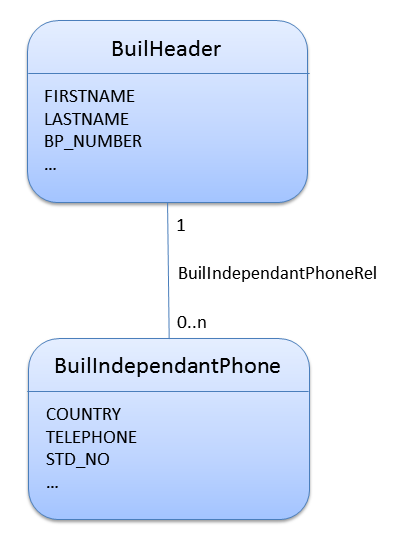Olaf Pohlmann
Read all my blogsThis one is for the CRM developers out there. A very specific topic this time: BPath. What is it? BPath is a query language from which you can access data and objects in the Business Object Layer by specifying commands in a character string. It doesn’t allow for things you cannot do otherwise but it certainly allows you to do things in a much more compact and code-efficient way.
The basics
The first examples are based on the following data model containing two Business Objects, one representing an account and the other one the related phone information. Check transaction GENIL_MODEL_BROWSER to look up all entity definitions and relations including the names of attribute-structures. More on the Business Object Layer and useful tools can be found here.
Let’s start with some simple BPath examples:
“Read a single telephone number of an account
data lv_phone_ref type ref to crmst_telephone_buil-telephone.
lv_phone_ref ?= lr_builheader->get_properties_by_bpath(
`BuilIndependantPhoneRel/@TELEPHONE` ).
if lv_phone_ref is bound.
write / lv_phone_ref->*.
endif.
“Read all phone attributes
data ls_phone_ref type ref to crmst_telephone_buil.
ls_phone_ref ?= lr_builheader->get_properties_by_bpath(
`BuilIndependantPhoneRel/*` ).
if ls_phone_ref is bound.
write: / ls_phone_ref->*-telephone, ls_phone_ref->*-country.
endif.
“Read all attributes of all existing phone entities
types tt_phone type standard table of crmst_telephone_buil with default key.
data lt_phone_ref type ref to tt_phone.
lt_phone_ref ?= lr_builheader->get_properties_by_bpath(
`BuilIndependantPhoneRel/*$` ).
if lt_phone_ref is bound.
loop at lt_phone_ref->* assigning <ls_phone>.
write: / <ls_phone>-telephone, <ls_phone>-country.
endloop.
endif.
The GET_PROPERTIES_BY_BPATH–method in the above examples is used to read one or more properties of the entity BuilIndependantPhone which is accessed by following relation BuilIndependantPhoneRel from source entity BuilHeader. The specified return type is a very generic one: REF TO DATA. The actual return type depends on whether you request a:
- single attribute (@TELEPHONE)
- structure with all attributes (*)
- table with all attributes from several entities (*$)
- table with a single attribute from several entities (@TELEPHONE$)
Multiple relations
One of the powers of BPath is the ability to follow several relations in one go:
“Follow several relations
data lr_btstatus type ref to cl_crm_bol_entity.
lr_btstatus = lr_btorder->get_related_entities_by_bpath(
`BTOrderHeader/BTHeaderStatusSet/BTStatusHCurrent/*$` ).
Notice that a different method is used this time: GET_RELATED_ENTITIES_BY_BPATH. This method returns a collection of entities. Remember to use the $-character to retrieve all entities otherwise the collection will never contain more than 1 entry! Also note that you have to specify the names of the relations in order to retrieve all relevant entities.
Filtering
Another great aspect of BPath is the possibility to apply filters in a simple manner. Let me demonstrate by giving another example:
“Get the standard telephone entity from the standard address
data lr_phone type ref to cl_crm_bol_entity.
lr_phone = lr_builheader->get_related_entities_by_bpath(
`BuilStandardAddressRel/
BuilStandardAddressPhoneRel[@STD_NO=”X”]/*` )->get_first( ).
This time only telephone entities are returned for which the attribute STD_NO has the specified value and from the resulting collection the first match is directly stored as an entity. This is powerful stuff! You can retrieve directly the entity you need without using any collections or iterators. And although the collection may be empty, it is always instantiated making it save to directly request the first one.
“It’s possible to filter on any relation along the path
data lr_phones type ref to if_bol_entity_col.
lr_phones = lr_builheader->get_related_entities_by_bpath(
`BuilAddressRel[@STANDARDADDRESS=””]/
BuilAddressPhoneRel[@VALIDTODATE>=#20140101#]/*$` ).
Note that string values are written between double quotes and dates between #.
Logical AND/OR
Use a “&” for a logical AND and the “|” for a logical OR.
“Retrieve the current roles
lr_builheader->get_properties_by_bpath(
`BuilRolesRel[(@VALID_FROM<=Today())&(@VALID_TO>=Today())]/@PARTNERROLE$` ).
“Check whether an account has role A or B
check lr_builheader->get_properties_by_bpath(
`BuilRolesRel[(@PARTNERROLE=”A”)|(@PARTNERROLE=”B”)]/*` ) is bound.
You might run into limitations when using more than 2 conditions. See also BPath: Filter by multiple criteria. Workaround is using additional parentheses like this:
MyRel[((@ATTR1=”A”)|(@ATTR1=”B”))|(@ATTR1=”C”)]/*$
And much more
Since BPath operates on a string containing the BPath commands it combines perfectly with the new possibilities of string templates. When used together they enable compact yet advanced queries:
“Check whether there is a relation with a specific partner
check lr_builheader->get_properties_by_bpath(
|BuilRelationshipRel[@PARTNER1=”{ lv_partner }”]/*| ) is bound.
Of course much more is possible with BPath. This blog mostly covers the ways in which I have used it. Check the blog series from Jürgen Gatter to learn all the details of BPath.






5 responses to “The power of BPath”
Thanks, very interesting and I wasn't aware of BPath. What about performance though? Is it better to use BPath compared to more "traditional way" of BOL programming where we iterate through the collections and so on?
Regards, David.
Thanks, I am please with the helpful information that you are providing to SAP CRM Community
Good article.
Regarding performance, i had made a benchmark a year ago with a report that was extraction data
– using bol
– using bpath
The difference wasn't really big or at least not big enough to be a concern using bpath.
The beauty of bpath is that you can build very dynamic programming.
Cheers,
Helder
Thanks for your interest in the blog. My advice and approach is always to start with nice clean code, and BPath certainly helps, and tackle performance problems when you encounter any. Since BPath works on the Business Object Layer and most of the heavy work is done in the Generic Interaction Layer I wouldn't expect (and didn't notice myself) a noticeable performance difference compared to the traditional approach.
Jürgen Gatter also addresses this topic in BPath Lesson 6 “Unstructured returns, sorting and performance considerations”. See the link at the end of the blog.
Hello,
Thanks a lot for this amazing Bpath article and all your previous Knowledge Sharing.
This is surely gonna help developers a lot.
Keep up the great work !
Cheers
Sheetanshu